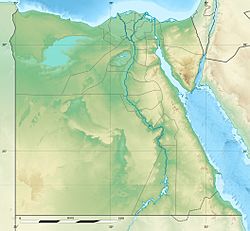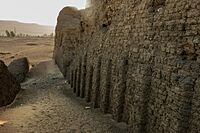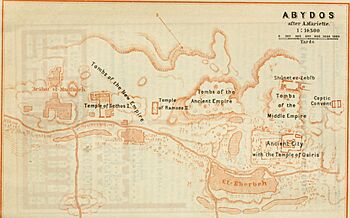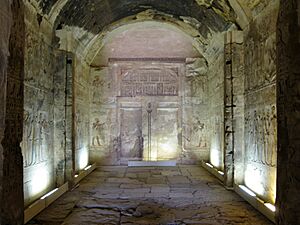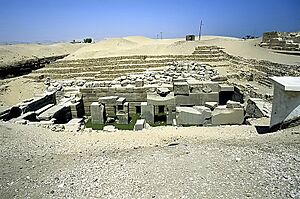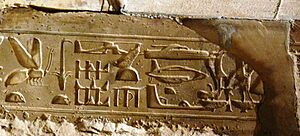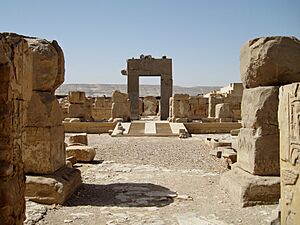Abydos, Egypt facts for kids
|
أبيدو
|
|
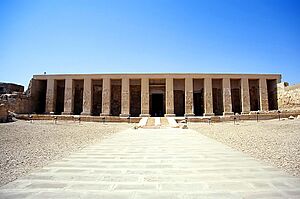
Façade of the Temple of Seti I in Abydos, built c. 1300 BCE
|
|
| Alternative name | Ⲉⲃⲱⲧ; Abedju |
|---|---|
| Location | El-Balyana, Sohag Governorate, Egypt |
| Region | Upper Egypt |
| Coordinates | 26°11′06″N 31°55′08″E / 26.18500°N 31.91889°E |
| Type | Settlement |
| History | |
| Periods | First Dynasty to Thirtieth Dynasty |
Abydos (Arabic: أبيدوس, romanized: Abīdūs) is one of the oldest and most important cities of ancient Egypt. It is located in Upper Egypt, about 11 kilometers (7 miles) west of the Nile River. Today, it is near the modern towns of El Araba El Madfuna and El Balyana.
In ancient Egyptian, the city was called Abedju. The name Abydos comes from the Greek word Ἄβυδος. This name was borrowed by Greek geographers from another city called Abydos in a different region.
Abydos name in hieroglyphs
Abydos was a very important religious center. It had many ancient temples and was home to Umm el-Qa'ab, a special burial ground for early pharaohs. People believed these tombs were very sacred. Later, many wanted to be buried nearby, which made Abydos even more important as a holy place.
Today, Abydos is famous for the memorial temple of Seti I. This temple has an important list of pharaohs called the Abydos King List. This list shows the names of most Egyptian pharaohs from Menes up to Seti I's father, Ramesses I. Abydos is also known for the Abydos graffiti, which are ancient writings found on the walls of the Temple of Seti I.
Much of the old town and the Great Temple are now buried under modern buildings. Many original structures and artifacts have been lost or destroyed due to new construction.
Contents
History of Abydos

Abydos played a big role in uniting Upper Egypt during the Naqada III period (3200–3000 BCE). Rulers from Abydos gained power over other cities like Hierakonpolis. Some ancient carvings, like those on the Gebel el-Arak Knife, might show these early conflicts.
Archaeologists have found tombs and at least one temple from the time before the pharaohs ruled all of Egypt. These are located at Umm El Qa'ab. One important tomb belongs to Narmer, who lived around 3100 BCE. The city and its cemetery were used continuously for thousands of years, with new buildings added over time.
Early Pharaohs and Tombs
The pharaohs of the First Dynasty were buried in Abydos. This includes Narmer, who is thought to be the first pharaoh of a united Egypt, and his successor, Aha. During this time, special boats called the Abydos boats were built. Some pharaohs from the Second Dynasty were also buried here. These pharaohs also rebuilt and made the temple bigger.
Large enclosures, sometimes called "forts" by modern researchers, were built behind the town by three kings of the Second Dynasty. The most complete one is the Shunet El Zebib, built by Khasekhemwy.
- King Khasekhemwy fort
-
King Khasekhemwy "fort" in Abydos. c. 2700 BCE
-
King Khasekhemwy "fort" in Abydos.
Rise of Osiris Worship

From the Fifth Dynasty, a local god named Khenti-Amentiu became linked with the dead pharaohs in the underworld. Later, this god merged with Osiris, the god of the afterlife. Abydos then became the main center for worshipping Isis and Osiris.
Many wealthy families made pilgrimages to Abydos. They believed the Early Dynastic cemetery was the burial place of Osiris himself. This made Abydos a very important holy city for ancient Egyptians.
Later Dynasties and New Temples
During the Twelfth Dynasty, King Senusret III had a huge tomb carved into the rock. Near it, a special temple and a small town called "Wah-Sut" were built for the workers.
Later, during the Eighteenth Dynasty, Ahmose I built a large chapel and the Pyramid of Ahmose I in Abydos. This is the only pyramid in the area, and very little of it remains today. Thutmose III built an even larger temple.
Seti I, from the Nineteenth Dynasty, built a famous temple to honor the pharaohs who came before him. His son, Ramesses II, finished this temple and also built a smaller one for himself.
The last major building added was a new temple by Nectanebo I in the Thirtieth Dynasty. After the Greeks took over Egypt, the structures in Abydos slowly started to fall apart.
Ancient Brewery Discovery
On February 14, 2021, archaeologists found what might be the oldest brewery in the world in Abydos. It dates back to around 3100 BCE, during the time of King Narmer. Experts believe it was used to make beer for royal religious ceremonies.
Main Sites of Abydos
Seti I Temple
The temple of Seti I is one of the most complete and impressive buildings in Abydos. It was built to honor King Seti I and to show respect for the early pharaohs.
Inside, there is a famous wall carving called the "Abydos King List". This list shows the names of many pharaohs from the first, Narmer (or Menes), up to Seti's time. This list is very important because it gives us a nearly complete record of ancient Egyptian kings.
The temple also has seven chapels for worshipping the pharaoh and important gods like Ptah, Re-Horakhty, and Amun. There are also chapels for the gods of Abydos: Osiris, Isis, and Horus. The carvings in these chapels show the daily rituals performed in temples across Egypt.
Behind the temple is a mysterious structure called the Osireion. It was a special tomb for Seti-Osiris, linked to the worship of Osiris. The temple was originally very long, but today, the well-preserved part is about 76 meters (250 feet) long and 107 meters (350 feet) wide.
The carvings in Seti I's temple are known for their beautiful details and artistic style. They show religious scenes and the transformation of the king after his death.
King's List
Osireion
The Osireion is an ancient Egyptian temple located behind the temple of Seti I. It was part of Seti I's burial complex and looks like a tomb from the 18th Dynasty in the Valley of the Kings.
Helicopter Hieroglyphs
Some hieroglyphs carved in the Temple of Seti I have caused a lot of discussion. Some people think they show modern technology like a helicopter, a submarine, or a plane.
However, experts explain that these images are actually the result of older carvings being changed over time. The original carving was made during Seti I's rule. Later, during the rule of Ramesses II, the carving was covered with plaster and re-carved. Over time, the plaster has fallen away, making both sets of carvings partly visible and creating the strange overlapping images.
Ramesses II Temple
The temple of Ramesses II is next to Seti I's temple. It is smaller and simpler. Its outside walls were decorated with scenes showing Ramesses II's achievements, like the Battle of Kadesh. This temple also had a list of pharaohs, similar to Seti I's, but its pieces were moved to the British Museum.
King's List
Umm El Qa'ab


The royal burial grounds of the earliest pharaohs are located about a mile into the desert. This area is now called Umm El Qa'ab, meaning "The Mother of Pots," because of all the broken pottery left by ancient pilgrims.
The earliest tombs were simple pits lined with brick walls. Later, tombs became larger and more complex. The pharaoh's burial chamber was often surrounded by smaller rooms for offerings. Many dozens of small pits, believed to be for the pharaoh's servants, surrounded the royal chamber. Evidence suggests that early tombs included offerings of animals, like the donkeys found in the tomb of Merneith. Over time, the practice of burying servants with the pharaoh changed to symbolic offerings.
By the end of the Second Dynasty, tombs changed to long passages with chambers on either side. The royal burial was usually in the middle. Most of the tomb contents have been destroyed by robbers over time. However, enough remains to show that rich jewelry was placed on mummies, and valuable stone vases filled with wine and perfumed oils were stored in the rooms. Tablets made of ivory and ebony recorded yearly events of the pharaohs' reigns.
A cemetery for ordinary people was also used from the First Dynasty onwards. It grew very large during the Twelfth and Thirteenth Dynasties and contained many rich tombs. People continued to be buried here until the Roman period.
"Forts"
Some large tomb structures, which researchers call "forts," are located behind the town. One, called Shunet ez Zebib, is still 9 meters (30 feet) high. It was built by Khasekhemwy, the last pharaoh of the Second Dynasty. Another similar structure is nearby, and a third is now used by a Coptic Orthodox Church of Alexandria convent.
Kom El Sultan
The area known as Kom El Sultan is a large mudbrick structure. Its exact purpose is unclear, but it is thought to be part of the original settlement area from the Early Dynastic Period. This area also includes the early temple of Osiris.
See Also
- List of ancient Egyptian towns and cities
- S 9 (Abydos)
- S 10 (Abydos)
- Mahat chapel of Mentuhotep II



